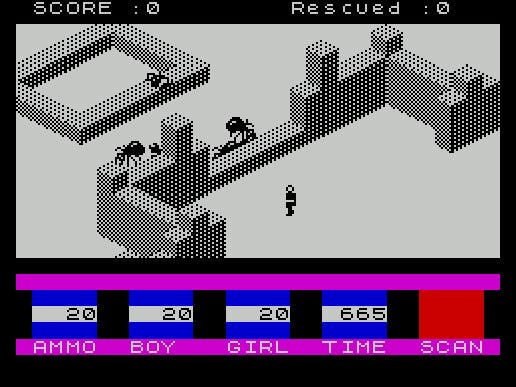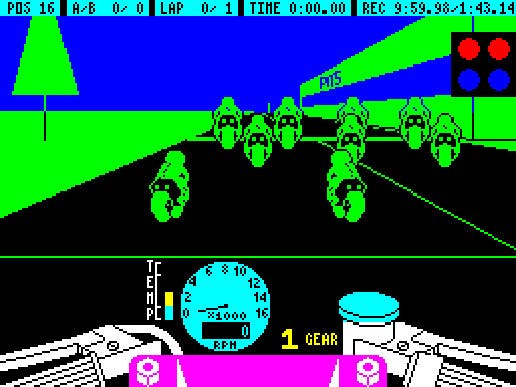Broadening the Spectrum
Somewhere over the rainbow.
In order to fulfil Sir Clive Sinclair's noble aim of delivering affordable machines to the masses, the Spectrum was a bare bones computer with very few external connectors. But through its single expansion port, users could bolt on all manner of hardware devices. Joystick interfaces were very common, as the 'zombie flesh' keyboard didn't exactly lend itself to gaming. Other popular add-ons included the Currah Microspeech, the Cheetah Specdrum and Romantic Robot's Multiface. Sir Clive was not about to leave the market completely open to third parties, however. His Cambridge-based team had been working on the official Interface 1 and 2 add-ons ever since the Spectrum's launch.
Announced in April 1982, the Interface 1 eventually shipped from Sinclair's famously rubbish mail-order department 16 months later. Was it worth the wait? The answer had to be yes, as it offered three modules for a reasonable £50. First and foremost, the Interface 1 connected the Spectrum to the whizzy new Microdrive storage device. This was Sir Clive's low-cost alternative to expensive floppy disk drives. For a fraction of the cost, Microdrive cartridges offered around 90Kb of fast, random access storage. Compared to cassettes, Microdrive access was around 30 times faster, taking seconds to load programs instead of minutes. What's more, up to eight Microdrives could be connected at once, providing users with a staggering 720Kb of storage.

The Interface 1 also featured an industry standard RS232 serial interface, allowing Spectrum owners to connect printers, modems and other devices. Finally, there was the superb-sounding 'ZX Net' - a network connection which could be used to connect up to 64 Spectrums! These LAN capabilities were no doubt included to make the Spectrum more attractive to schools. Sir Clive's efforts were wasted however, as the education authorities were already snuggled up in a cold bed with Acorn. It's estimated that Sinclair captured less that 2% of the educational market.
Right from the outset, the Microdrive technology was plagued with reliability problems. Yes, it was meant to be cheap and cheerful, but losing precious data was no laughing matter. Cartridges contained a continuous loop of magnetic tape which was spun past the head at 16 inches per second. Data transfer was therefore fast, but the fragile tape was placed under considerable pressure, and sometimes would be chewed up by the drive mechanism. It was also revealed that if the Spectrum ran out of memory and crashed, the Microdrive would carry on spinning and completely erase the contents of the cartridge. Ouch.

Still, the Microdrive was generally well received in the computing press, especially by the games magazines which predicted a bright future filled with epic Microdrive-based adventure games - or "epicventures", as Franco Frey referred to them in the May 1984 issue of Crash magazine. "The cheap and fast Microdrive storage systems will open up a whole new world of adventure games," predicted Franco. "Imagine popular adventures such as The Hobbit or Valhalla then extend the number of locations by a factor of say 10 or 20 and you will soon see that your chance of getting lost forever in adventureland increases alarmingly. No doubt adventure games writers are at this very moment labouring away frantically at their first Microdrive epics and we will see some results in the near future."
It was easy to see where Franco was coming from. Full-screen location graphics could be stored on cartridge and then displayed on demand, effectively nullifying the restrictions of the 48Kb memory. Sadly, no such titles emerged, mainly because the adventure game market was largely dominated by small software houses who didn't have the time and resources available to create these super-sized adventures.

In fact, only one game of note was actually released on Microdrive cartridge, and that was Quicksilva's Ant Attack. This appeared as part of a special 'Spectrum Expansion Pack' which included an Interface 1, a Microdrive and a collection of four cartridge programs. Besides Ant Attack, the bundled titles were Games Designer (a game creation tool, also by Quicksilva), Masterfile (a filing and retrieval system) and Tasword Two (a word processor). There were no "epicventures" however, and while Ant Attack was great, it had been available on cassette for well over a year.
A small number of cartridge-based utilities followed, but Microdrive support rarely extended beyond the built-in options to backup tapes to cartridge. Hill MacGibbon's Rally Driver and CP Software's Bridge Player 3 offered this, as did Softek's The Writer and Gilsoft's The PAW. Alternatively, you could use utilities like Romantic Robot's Trans-Express to copy any tape to cartridge.








